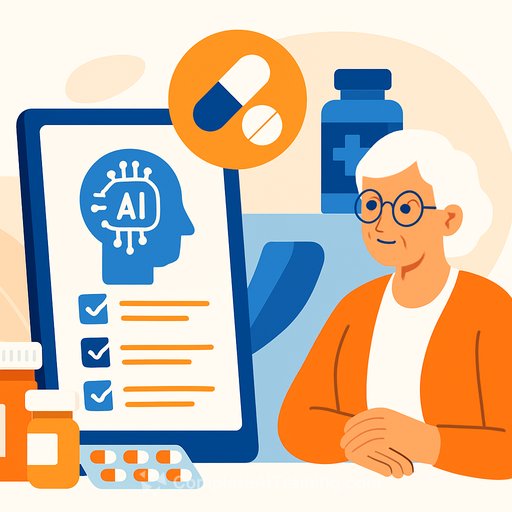Artificial Intelligence in Managing Polypharmacy Among Older Adults: A Scoping Review
Abstract
Artificial intelligence (AI) offers a promising approach to improving medication management for patients on multiple drugs. However, research on AI's role specifically in managing polypharmacy among older adults remains limited. This review examined studies involving adults aged 50 and above, focusing on AI applications in managing complex medication regimens.
Out of 58 initial citations from EMBASE, Ovid MEDLINE, and Web of Science, five articles met the criteria for detailed analysis. These studies explored AI and web-based tools to reduce inappropriate medication use and drug interactions, machine learning systems to enhance medication adherence, and pattern recognition between multimorbidity and polypharmacy in chronic illness.
The findings indicate AI tools can efficiently identify drug-drug interactions, detect potentially inappropriate medications (PIMs), and recognize multimorbidity patterns linked to polypharmacy. Additionally, AI applications appear user-friendly and support better medication adherence. These tools hold potential for improving medication safety and predicting medication-related risks in older adults. Further research should evaluate long-term patient outcomes, personalized pharmacotherapy, and address challenges such as algorithm transparency and regulatory oversight.
Introduction & Background
Medication prescribing has surged, leading to challenges like increased healthcare costs, opioid-related deaths, and addiction disorders. Older adults, who often require multiple medications, face heightened risks of inappropriate use and related complications.
AI offers opportunities to improve medication management by enhancing the understanding of drug interactions, predicting adverse outcomes, and supporting adherence. Aging alters drug absorption, metabolism, and elimination, increasing toxicity risks due to declining liver and kidney function and changes in body composition.
Polypharmacy is common in older adults because of multiple chronic conditions. This raises risks of drug-drug interactions (DDIs) and adverse effects, especially when combining prescription and over-the-counter drugs. Current medication guidelines often focus on single diseases, overlooking the complexity of comorbidities and multiple drug regimens.
Older adults also experience increased drug sensitivity, leading to stronger side effects even at lower doses. Cognitive decline and physical impairments further complicate safe medication management, increasing the chances of non-adherence and errors.
Pain management, a frequent medical concern, often involves opioids and NSAIDs, which carry risks such as falls and fractures in older adults. Impaired organ function exacerbates these risks by affecting drug clearance.
These factors highlight the need for individualized medication plans that include dose adjustments, monitoring, and strategies to minimize risks. Integrating DDI prevention with comprehensive medication management is crucial to ensuring safety and effectiveness in this population.
Artificial Intelligence (AI) and Pharmacology
AI shows promise in analyzing complex problems and generating solutions. For instance, AI tools like ChatGPT can assist in medical education by creating exam questions, demonstrating acceptable accuracy and efficiency.
In clinical practice, AI can identify general DDIs and offer management recommendations. It assists pharmacists with tasks such as documentation and summarization. However, AI's role in recommending specific drugs or alternatives is still limited and requires expert oversight to ensure accuracy.
For example, querying AI about interactions between apixaban and fluconazole can yield detailed information on pharmacokinetics and monitoring strategies. Despite its potential, caution is vital to avoid errors and maintain personalized care.
Machine Learning (ML) and Polypharmacy
Machine learning (ML), a subset of AI, enables systems to learn from data using algorithms. Clinicians can use ML to predict medication behaviors and optimize treatment. Large language models (LLMs) such as ChatGPT process language-based data to provide informed responses, enhancing support for medication management.
Pharmaceutical Management and Older Adults
Despite growing evidence of AI’s clinical impact, few studies focus on its application in managing polypharmacy among older adults. Some research highlights higher DDI risks in hospital settings compared to primary care or nursing homes.
This review addresses the complexity of medication management in older adults due to physiological changes, polypharmacy, and comorbidities. Current strategies often fall short in preventing adverse DDIs. AI may offer solutions, but safety, accuracy, and efficacy need further study.
Review Methods
This scoping review followed the Joanna Briggs Institute (JBI) methodology, analyzing peer-reviewed studies from 2020 to 2024. It focused on adults aged 50 and older, evaluating AI’s accuracy and safety in managing multiple medications.
Databases searched included EMBASE, Ovid MEDLINE, and Web of Science. The search used terms related to polypharmacy, AI in healthcare, machine learning, and elderly populations. From 58 screened articles, five met inclusion criteria after rigorous review.
Data extraction and screening were supported by tools like Rayyan and Microsoft Excel. The JBI Critical Appraisal Tools ensured articles were of sufficient quality and low risk of bias.
Results
AI and Medication Safety
Studies demonstrated that AI and web applications significantly improve detection of PIMs and harmful DDIs. For example, AI systems in Turkey and China identified inappropriate drugs and interactions much faster and more accurately than manual methods.
One Turkish study’s web application detected inappropriate drugs and interactions about 100 times quicker than traditional literature reviews. Another found that AI-assisted tools eliminated inappropriate DDIs among polypharmacy patients.
In Chinese outpatient settings, AI models like Classifier Chain and CatBoost showed superior speed and accuracy in detecting PIMs. Implementing AI tools combined with clinical decisions eliminated contraindicated DDIs in nursing home patients. These findings highlight AI’s potential for bedside application to improve medication safety.
AI and Medication Adherence
Beyond safety, AI supports better medication adherence. Machine learning and audio-based recognition systems can remind and encourage older adults to take medications as prescribed.
Participants in studies found these tools accurate, user-friendly, and helpful in daily management. This suggests AI can enhance adherence by addressing common barriers such as forgetfulness or confusion.
AI in Risk Prediction and Patient Stratification
AI predictive models identify patient subgroups at high risk of complications from polypharmacy, such as those with overlapping cardiovascular diseases. These insights enable clinicians to prioritize interventions for those most in need, improving care efficiency.
Synthesis and Gaps
Overall, AI tools show promise in improving drug safety, adherence, and risk stratification for older adults. However, research lacks data on long-term clinical outcomes like mortality and healthcare utilization.
Additionally, differences in international PIM criteria limit result consistency. For example, some PIMs common in the US are rare in China and vice versa. Establishing standardized global criteria would enhance research comparability.
Despite geographic and methodological differences, all reviewed studies supported AI’s effectiveness in detecting PIMs. Continued research is needed before widespread clinical adoption, but current evidence supports AI’s growing role in medication management.
Discussion
Medication Safety: Potential and Challenges
AI can significantly improve medication safety by rapidly identifying PIMs and complex interactions that manual review might miss. Timely AI alerts can reduce preventable adverse drug events and support safer prescribing.
Successful clinical integration requires seamless linking with electronic health records, validation across settings, and ongoing monitoring as new drugs emerge. Challenges include clinician skepticism, alert fatigue, and overreliance on AI decision support.
Ethical concerns about patient privacy and data security also require strong regulatory frameworks and professional training to maintain trust and confidentiality.
Medication Adherence: Usability and Acceptance
AI tools tackling adherence offer solutions to forgetfulness, misunderstanding, and motivation challenges common in older adults with chronic conditions. When designed to fit patients' cognitive and physical abilities, these tools empower patients and enable early clinician intervention.
However, disparities in digital literacy and access could limit reach. Inclusive design, integration with existing supports, and co-development with users will help maximize benefits and reduce inequities.
Ongoing evaluation of user satisfaction, security, and engagement is essential to ensure adherence tools remain effective and trusted.
For those interested in expanding AI skills applicable to healthcare and management, exploring specialized courses on Complete AI Training can provide practical knowledge on AI applications across various fields.
Your membership also unlocks:










